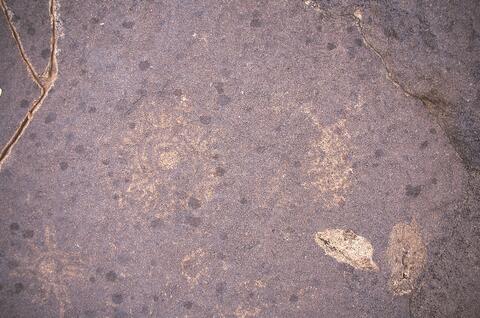Identity area
Reference code
Title
Date(s)
- 27/02/2002 (Creation)
Level of description
Extent and medium
Context area
Name of creator
Biographical history
Brief description of site: RSA PRG1 comprises a low rise of dolerite rock on the 1 520 m contour next to a very strong natural spring. On top of the low hill one has a good all-round view and the site is situated at the juncture of a natural corridor of movement for animals and people.
On account of the natural spring, this site has been a long-term focus for humans. The area around the spring is covered in stone artefacts. Most of these artefacts are made from indurated shale (also known as 'hornfels' or 'lydianite'). There are at least two distinct types of lithics. The larger flakes belong to Khoekhoen herders (previously known as the Khoikhoi or 'Hottentots') and date to between 1 300 - 200 years ago while the smaller lithics tend to be the product of hunter-gatherers known as 'Bushmen' or 'San' and these tools belong to the Later Stone Age, which covers the period from about 25 000 years ago until historic times. Lithics (stone tools) of every description literally carpet the surface of the site. Recognisable among the tools or 'lithics' are many belonging to the Smithfield Industry, most of which dates to between 8 000 - 12 000 years ago. Every stage of stone tool manufacture is present at RSA PRG1. There are cores - large lumps of rock from which stone tools are made. There are flakes - general-purpose cutting tools. Adzes are present and were used for woodworking in much the same way as a spokeshave. End and side-scrapers, often in the shape of a thumbnail were used to prepare leather. There are also rare burins and awls - used to pierce. Ostrich eggshell beads are said to have been abundant in the past and grit-tempered pottery as well as porcelain is also found here. This diversity and density of stone tools show that this was a favoured home and meeting place of many peoples such as the Bushmen and Khoekhoen. The remains of 'Pitman's' house foundations - where an early European 'bywoner' lived - to the south-west of the spring shows how all cultures were attracted to this place. Nearer to the engravings there are numerous and extensive rock surfaces that have been worn smooth by people grinding seeds, ochre and such like on them.
Brief description of art: There are three engraved rocks on the low hill at RSA PRG1. These engravings are not the typical Bushman engravings, but belong to the Khoekhoe herder peoples who lived in this area 1 300 - 200 years ago.
Rock 1: On the northern slope, lower down is a small boulder with three concentric circle designs pecked into the rock. Each of the circles has paired rays coming off it, making these look like 'sunbursts' designs (which they are not, see explanation, below).
Rock 2: A long narrow rock with 5 pecked 'sunburst' motifs lightly pecked into it.
Rock 3: This is more accurately a collection of rocks or stapelklip. This collection of rocks shows signs of having been struck with a small stone to produce sound. These 'gong rocks' are a feature of Southern Africa and show that sound was important to people in the past. Please do not hit the rock yourself, as this will contaminate future dating attempts! On the 40° sloping rock surface there are at least 9 lightly pecked concentric circles and 'sunbursts' as well as two lozenge-shaped designs that we know represent either Khoekhoe women's front aprons or the men's front loincloth.
Threat(s) to site: The site is in a good condition though the engravings are best viewed early in the morning or late in the afternoon. Many of the site's artefacts have been removed and it is essential that all artefacts be left where they are found. It is illegal to remove artefacts from an archaeological site. The building of the cement dam caused unwitting damage and trampling from stock and people are also problems.
Name of creator
Biographical history
Nationality: South African
Created by: willem
Created on: 11/03/2003
Name of creator
Biographical history
Repository
Archival history
Immediate source of acquisition or transfer
Content and structure area
Scope and content
Appraisal, destruction and scheduling
Accruals
System of arrangement
Conditions of access and use area
Conditions governing access
Conditions governing reproduction
Language of material
- English
Script of material
Language and script notes
Physical characteristics and technical requirements
Original size: 35mm

